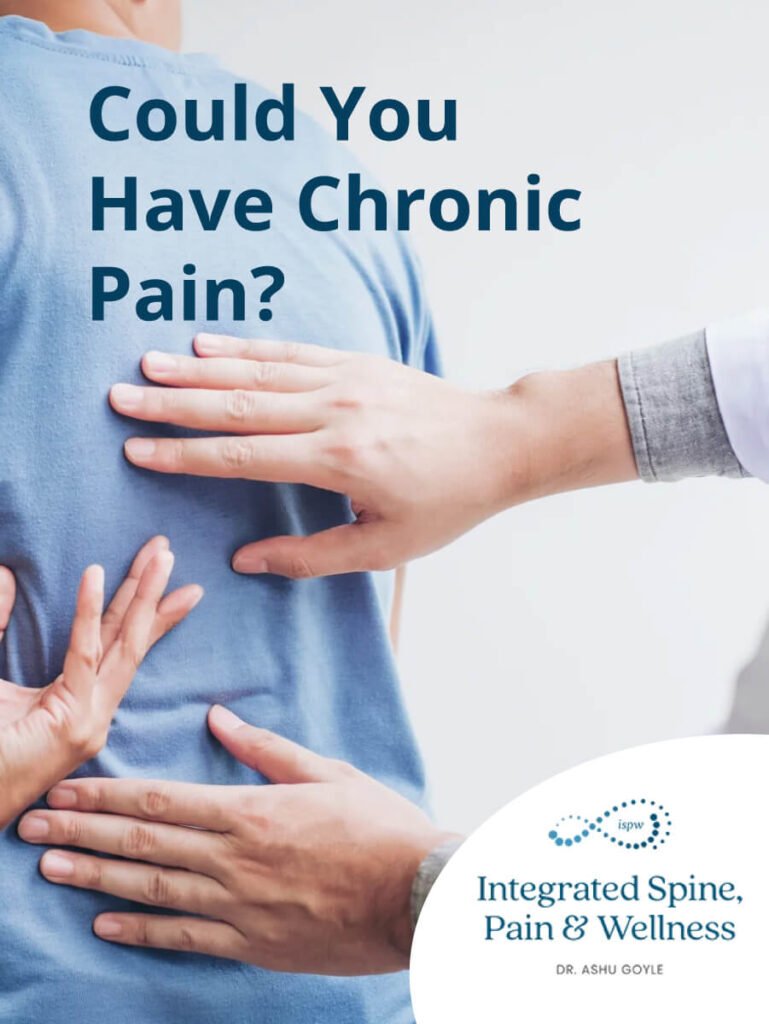Chronic pain affects millions of people worldwide, disrupting daily lives and diminishing quality of life. Imagine waking up each day, unsure if you’ll be able to function normally or be sidelined by relentless, persistent pain. This pervasive issue calls for a deeper understanding and effective solutions. Chronic pain is defined as pain that lasts longer than three months, often continuing even after the initial injury or illness has healed. Unlike acute pain, which serves as a warning signal, chronic pain persists, often without a clear cause. It can affect any part of the body and varies in intensity from mild discomfort to debilitating agony. Understanding chronic pain and its causes is crucial for developing effective treatment plans and improving patient outcomes. By identifying the underlying factors contributing to chronic pain, healthcare providers can tailor interventions that not only alleviate pain but also address its root causes. This comprehensive approach can lead to better management, enhanced quality of life, and, ultimately, long-term relief for those suffering from chronic pain. Effective solutions and a clear understanding of chronic pain can make a significant difference in the lives of those affected, providing them with the hope and tools needed for a pain-free future.
Medical Causes of Chronic Pain
Chronic pain can arise from various medical conditions, each contributing to persistent discomfort and diminished quality of life. One of the primary sources of chronic pain is musculoskeletal issues. Arthritis, for example, is a common cause, characterized by inflammation of the joints leading to pain and stiffness. There are different types of arthritis, such as rheumatoid arthritis and psoriatic arthritis, both causing significant discomfort. Fibromyalgia is another musculoskeletal condition that triggers widespread pain, fatigue, and tenderness in the muscles and soft tissues, often accompanied by sleep disturbances and cognitive difficulties. Osteoarthritis, which involves the degeneration of joint cartilage and underlying bone, primarily affects the knees, hips, and hands, resulting in pain, swelling, and reduced motion.
- Neurological causes also play a significant role in chronic pain. Neuropathy, a condition resulting from damaged nerves, can cause pain, numbness, and weakness, often in the hands and feet. This condition is frequently associated with diabetes but can also arise from infections, injuries, and exposure to toxins. Multiple sclerosis (MS) is another neurological disorder where the immune system attacks the protective covering of nerves, leading to communication problems between the brain and the rest of the body. This can result in chronic pain, muscle spasms, and other debilitating symptoms. Migraines, severe headaches often accompanied by nausea, vomiting, and sensitivity to light and sound, are also a common source of chronic pain. These intense headaches can significantly impact daily life and persist for extended periods.
- Injuries and trauma are major contributors to chronic pain. The long-term effects of accidents, such as car crashes or falls, can lead to ongoing pain and discomfort. Injuries may heal over time, but the pain can linger due to nerve damage, scar tissue, or other complications. Similarly, post-surgical pain can persist long after the surgical wounds have healed. This type of pain can be caused by nerve damage, infections, or scar tissue formation, making recovery challenging and prolonged.
- Inflammatory conditions are another important category of chronic pain causes. Inflammatory Bowel Disease (IBD), which includes Crohn’s disease and ulcerative colitis, involves chronic inflammation of the digestive tract. This inflammation can cause severe abdominal pain, diarrhea, and fatigue, significantly affecting the patient’s quality of life. Systemic Lupus Erythematosus (SLE), commonly known as lupus, is an autoimmune disease where the immune system attacks healthy tissues, causing widespread inflammation and pain. Lupus can affect joints, skin, kidneys, and other organs, leading to persistent pain and severe symptoms.
Understanding the various medical causes of chronic pain, such as musculoskeletal issues, neurological disorders, injuries and trauma, and inflammatory conditions, is crucial for effective management and treatment. By identifying the specific cause of chronic pain, healthcare providers can tailor treatments to address the root issues, providing relief and improving the quality of life for those affected. Whether dealing with arthritis, neuropathy, or inflammatory conditions like IBD and lupus, comprehensive care and targeted interventions can make a significant difference in managing chronic pain.
Psychological and Emotional Factors
- Stress and Chronic Pain: Stress is a significant contributor to chronic pain. When the body is under stress, it releases cortisol and other stress hormones that can exacerbate pain. Stress causes muscle tension, which can lead to headaches, back pain, and other forms of discomfort. Moreover, chronic stress affects the body’s ability to heal and can amplify the perception of pain. Managing stress through techniques such as mindfulness, relaxation exercises, and therapy can significantly reduce chronic pain symptoms.
- Depression and Anxiety: Depression and anxiety are closely linked to chronic pain. Individuals with chronic pain are more likely to experience depression and anxiety, which can, in turn, worsen their pain. Depression can lead to a lack of motivation to engage in physical activity or pursue treatment, while anxiety can heighten pain sensitivity and lead to muscle tension. Addressing these mental health issues through counseling, medication and cognitive behavioral therapy (CBT) can help break the cycle of pain and improve overall well-being.
- Post-Traumatic Stress Disorder (PTSD): PTSD is another psychological factor that can contribute to chronic pain. Individuals with PTSD often experience heightened sensitivity to pain and increased muscle tension. Traumatic events can cause changes in the brain that affect how pain is processed and perceived. People with PTSD may also experience anxiety and depression, which can further exacerbate pain symptoms. Treatment for PTSD, such as trauma-focused therapy and medications, can help reduce the impact of chronic pain.
By recognizing and addressing the psychological and emotional factors contributing to chronic pain, individuals can achieve better pain management and improve their quality of life. Integrating mental health support with physical treatment is essential for a holistic approach to chronic pain care.
Lifestyle and Environmental Factors
Chronic pain is often influenced by various lifestyle and environmental factors that can exacerbate or even cause pain. Understanding and addressing these factors is crucial for effective pain management.
- Poor Posture and Ergonomics: Poor posture and improper ergonomics are significant contributors to chronic pain, especially in the back, neck, and shoulders. Sitting or standing with incorrect posture can strain muscles and ligaments, leading to pain and discomfort. Using ergonomic furniture and maintaining proper posture can help alleviate and prevent chronic pain. Simple adjustments like proper chair height, monitor placement, and taking regular breaks to stretch can make a substantial difference.
- Sedentary Lifestyle: A sedentary lifestyle is another major factor contributing to chronic pain. Lack of physical activity can lead to muscle weakness, joint stiffness, and decreased flexibility, all of which can cause or worsen chronic pain. Regular exercise is essential for maintaining muscle strength and joint health. Activities such as walking, swimming, and stretching can help reduce pain and improve overall physical function. Incorporating more movement into daily routines can significantly impact pain levels.
- Diet and Nutrition: Diet and nutrition play a crucial role in managing chronic pain. Consuming a diet high in processed foods, sugar, and unhealthy fats can increase inflammation and exacerbate pain. Conversely, a diet rich in anti-inflammatory foods such as fruits, vegetables, whole grains, and lean proteins can help reduce inflammation and pain. Staying hydrated and avoiding excessive alcohol and caffeine intake are also important. Making healthier dietary choices can positively influence pain management.
- Substance Abuse: Substance abuse, including the misuse of alcohol and drugs, can significantly impact chronic pain. While some substances may provide temporary relief, they can lead to dependency and worsen pain over time. Substance abuse can also interfere with pain management treatments and negatively affect overall health. Seeking help for substance abuse through counseling, support groups, and medical treatment is crucial for those struggling with addiction. Addressing substance abuse can lead to better pain management and improved quality of life.
By understanding and modifying lifestyle and environmental factors such as posture, physical activity, diet, and substance use, individuals can better manage chronic pain. These changes, combined with medical treatments, can lead to a more holistic and effective approach to pain management.
Genetic and Hereditary Factors
Chronic pain can often be influenced by genetic and hereditary factors, playing a significant role in an individual’s susceptibility to pain.
- Genetic Predisposition: Genetic predisposition refers to the increased likelihood of developing chronic pain due to one’s genetic makeup. Certain genes can influence how pain is perceived and processed by the body. For instance, variations in the COMT gene can affect the way pain signals are transmitted, leading to heightened pain sensitivity. Understanding one’s genetic predisposition can help in developing personalized pain management strategies. By identifying these genetic markers, healthcare providers can tailor treatments to better address the unique needs of each patient, potentially improving outcomes and reducing chronic pain symptoms.
- Hereditary Conditions: Hereditary conditions are another critical aspect of chronic pain. Conditions such as Ehlers-Danlos syndrome, fibromyalgia, and rheumatoid arthritis can be passed down through families, increasing the risk of chronic pain for individuals with a family history of these disorders. These conditions often come with a range of symptoms that can contribute to chronic pain, including joint instability, muscle pain, and inflammation. Recognizing the hereditary nature of these conditions is essential for early diagnosis and intervention. By being aware of their family medical history, individuals can seek prompt treatment and take proactive measures to manage their chronic pain effectively.
Understanding the genetic and hereditary factors contributing to chronic pain is vital for developing comprehensive and effective pain management plans. By considering these factors, healthcare providers can offer more personalized and targeted treatments, leading to better pain control and improved quality of life for those affected by chronic pain.
Unexplained Causes and Idiopathic Pain
Chronic pain can sometimes arise without a clear, identifiable cause, posing unique challenges for both patients and healthcare providers.
- Idiopathic Pain: Idiopathic pain refers to chronic pain that has no identifiable cause. Despite thorough medical examinations and tests, the origin of idiopathic pain remains unknown. This type of pain can be particularly frustrating for patients, as the lack of a clear cause can make it difficult to develop effective treatment plans. However, recognizing idiopathic pain is the first step toward managing it. Treatment often focuses on symptom relief and improving the patient’s quality of life through various pain management strategies.
- Challenges in Diagnosis: Diagnosing idiopathic pain presents several challenges. Without a clear cause, it can be difficult to pinpoint effective treatments. Patients may undergo numerous tests and consultations with various specialists before a diagnosis is reached. This process can be time-consuming and emotionally taxing. Additionally, the absence of visible symptoms or identifiable causes can lead to misunderstandings and skepticism from others, including healthcare providers. It is crucial to approach idiopathic pain with a comprehensive and empathetic perspective, ensuring that patients receive the support and care they need.
Understanding idiopathic pain and the challenges in diagnosing it is essential for developing effective pain management strategies. By acknowledging the complexities of unexplained chronic pain, healthcare providers can offer more compassionate and tailored treatments, ultimately improving patient outcomes and quality of life.
Diagnosis and Assessment of Chronic Pain
Accurately diagnosing and assessing chronic pain is crucial for developing effective treatment plans. A thorough evaluation can help pinpoint the root causes and guide appropriate interventions.
- Medical History and Physical Examination: The diagnosis of chronic pain begins with a comprehensive medical history and physical examination. During this process, healthcare providers gather detailed information about the patient’s pain, including its onset, duration, intensity, and any factors that exacerbate or relieve it. Understanding the patient’s medical history, including previous injuries, surgeries, and underlying health conditions, is essential for identifying potential causes of chronic pain. The physical examination involves assessing the affected areas, evaluating the range of motion, and looking for signs of inflammation or other abnormalities. This thorough approach ensures that all possible factors contributing to the pain are considered.
- Diagnostic Tests: Diagnostic tests are often used to further investigate the causes of chronic pain. These tests may include imaging studies such as X-rays, MRI, or CT scans, which can reveal structural issues like fractures, herniated discs, or degenerative changes. Blood tests may be conducted to identify underlying conditions such as infections, autoimmune disorders, or metabolic imbalances. Nerve conduction studies and electromyography (EMG) can assess nerve function and detect abnormalities that might be causing pain. These diagnostic tools provide valuable insights that help in forming a precise diagnosis and tailoring the treatment plan accordingly.
- Pain Measurement Tools: Pain measurement tools are essential for quantifying the intensity and impact of chronic pain. Tools such as the Visual Analog Scale (VAS), the Numeric Rating Scale (NRS), and the McGill Pain Questionnaire allow patients to describe their pain levels and characteristics. These assessments help healthcare providers understand the severity of the pain and monitor changes over time. Additionally, tools like the Brief Pain Inventory (BPI) assess how pain affects daily activities, providing a comprehensive view of its impact on the patient’s life. Accurate pain measurement is vital for evaluating the effectiveness of treatments and making necessary adjustments to the pain management plan.
By combining a detailed medical history, thorough physical examination, appropriate diagnostic tests, and effective pain measurement tools, healthcare providers can develop a comprehensive understanding of chronic pain. This holistic approach ensures that patients receive the most accurate diagnosis and effective treatment strategies to manage their pain and improve their quality of life.
Treatment and Management of Chronic Pain
Effective treatment and management of chronic pain require a comprehensive approach that addresses both the symptoms and underlying causes. By combining various medical treatments, therapies, and lifestyle modifications, patients can achieve significant relief and improved quality of life.
- Medical Treatments: Medical treatments for chronic pain often include medications such as pain relievers, anti-inflammatory drugs, and muscle relaxants. These medications help to reduce pain and inflammation, making daily activities more manageable. In some cases, prescription medications such as opioids or antidepressants may be used to manage more severe pain. However, these are typically considered when other treatments have not provided sufficient relief, due to the risk of side effects and dependency.
- Therapies: Various therapies play a crucial role in managing chronic pain. Physical therapy helps to improve mobility, strengthen muscles, and reduce pain through targeted exercises and stretches. Occupational therapy assists patients in adapting their daily activities to minimize pain and improve function. Cognitive behavioral therapy (CBT) addresses the psychological aspects of chronic pain, helping patients develop coping strategies and reduce the emotional impact of pain.
- Alternative Treatments: Alternative treatments can offer significant relief for chronic pain. Platelet-rich plasma (PRP) therapy uses the patient’s own blood to promote healing and reduce inflammation in injured tissues. This treatment is particularly effective for injuries and conditions like arthritis. The MLS M6 laser therapy is another non-invasive option that helps to reduce pain, improve arthritis symptoms, and accelerate wound healing. By using Dr. Goyle’s signature method, which combines PRP, diet and movement modifications, and laser therapy, patients can optimize their treatment outcomes. This holistic approach aims to reduce pain, improve function, and enhance overall well-being.
- Lifestyle Modifications: Lifestyle changes are essential for managing chronic pain effectively. Regular exercise helps to maintain muscle strength and flexibility, reducing pain and improving mobility. A balanced diet rich in anti-inflammatory foods can help to reduce inflammation and support overall health. Stress management techniques such as mindfulness, meditation, and yoga can also play a significant role in reducing pain and improving quality of life.
By integrating medical treatments, various therapies, alternative treatments like PRP and MLS M6 laser therapy, and lifestyle modifications, patients can achieve a comprehensive approach to managing chronic pain. This multi-faceted strategy not only addresses the symptoms but also targets the underlying causes of pain, leading to better outcomes and an improved quality of life. Dr. Goyle’s signature method exemplifies this holistic approach, combining cutting-edge treatments with personalized care to help patients find lasting relief from chronic pain.
Conclusion
Chronic pain is a complex issue that can arise from a variety of medical, psychological, and lifestyle factors. Understanding these causes is crucial for effective management. Addressing chronic pain requires a multidisciplinary approach that combines medical treatments, therapies, alternative treatments, and lifestyle modifications. This comprehensive strategy ensures that patients receive personalized and effective care. We encourage those suffering from chronic pain to seek support and explore various treatment options. There is hope for relief, and with the right approach, you can achieve a better quality of life.
Additional Resources
For those seeking more information about chronic pain and its management, here are some valuable references and resources:
References and Further Reading:
- “Managing Chronic Pain” by Harvard Health Publishing.
- “The Pain Management Handbook” by Neville Shone.
- Articles from the American Chronic Pain Association (ACPA).
Support Groups and Organizations:
- American Chronic Pain Association (ACPA): Provides resources and support groups for people with chronic pain. Website
- Pain Connection: Offers support groups and resources for chronic pain sufferers. Website
- National Fibromyalgia Association: Provides information and support for those with fibromyalgia and chronic pain. Website
These resources can provide additional information, support, and community for those dealing with chronic pain, helping you navigate your journey toward better health and well-being.





